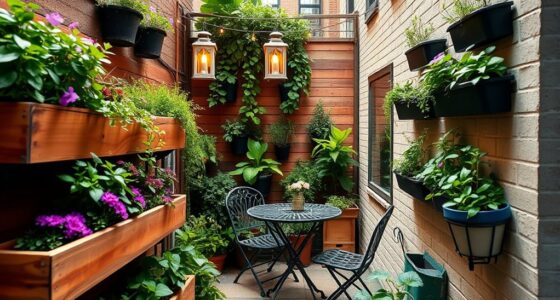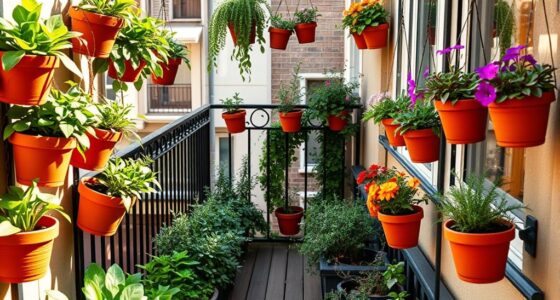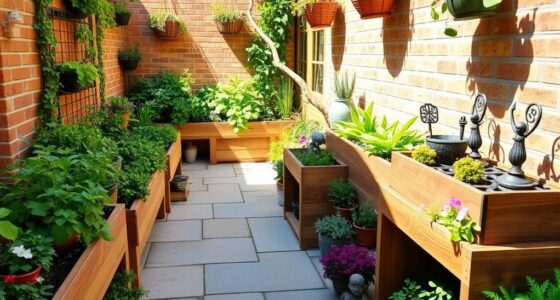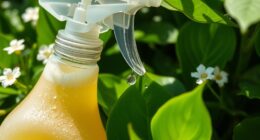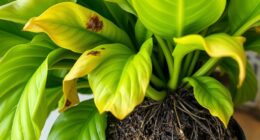To enhance your hydrangeas, plant vibrant blooms like tulips and daffodils at their base for early color. Add texture with broad-leaved hostas, Japanese forest grass, or coral bells, and consider variegated varieties for interest. Shade-loving plants like ferns and astilbes work well in low-light areas. To create contrast, include architectural grasses or succulents. For more ideas on combining plants for stunning color and texture, keep exploring your garden options.
Key Takeaways
- Combine hydrangeas with spring bulbs and climbing vines for vibrant, seasonal color and vertical interest throughout the year.
- Incorporate textured foliage plants like Japanese forest grass and coral bells to add depth and visual complexity.
- Use shade-tolerant plants such as ferns, hostas, and astilbes for shaded garden areas around hydrangeas.
- Pair hydrangeas with architectural plants like yucca and agave for striking contrast and modern landscape appeal.
- Enhance foliage variety with colors like burgundy or chartreuse, and define spaces with garden edging for a tidy, layered look.
Bright Blooms: Colorful Flowering Plants to Pair With Hydrangeas

To create a vibrant garden display, consider pairing hydrangeas with other colorful flowering plants that complement their lush blooms. Spring bulbs like tulips and daffodils add early-season bursts of color at the base of hydrangeas, creating a striking contrast. Climbing vines such as clematis or honeysuckle can be trained around the hydrangea shrub, providing vertical interest and additional layers of bright color. These vines also attract pollinators, enhancing your garden’s significance. Incorporating seasonal variations ensures your garden remains lively throughout the year, with different plants blooming at various times. Combining spring bulbs with hydrangeas offers a seamless shift from early to late blooms, ensuring your garden stays lively throughout the season. Be sure to select bulbs and vines that thrive in similar light and soil conditions for the best results. Incorporating natural materials like wood or stone around your planting beds can enhance the rustic charm of your garden, tying in nicely with the lush foliage of hydrangeas. Using companion plants can also improve the health and growth of hydrangeas by promoting better soil conditions and pest control. This pairing creates a lively, colorful display that highlights the hydrangea’s lush foliage.
Elegant Foliage: Plants That Add Texture and Depth
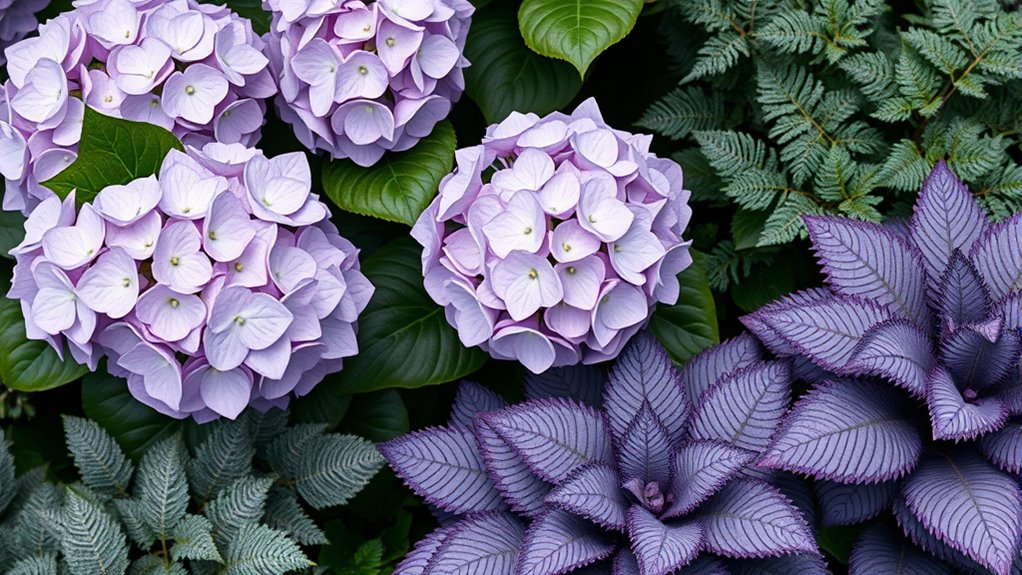
Adding plants with varied leaf shapes and contrasting colors instantly enhances your hydrangea bed’s visual interest. Texture-rich foliage varieties create depth and make your garden feel more dynamic. Choosing the right foliage plants helps you craft a lush, layered landscape that complements your hydrangeas beautifully. For optimal visual appeal, consider incorporating best garden plants, which are highly recommended for creating a balanced and attractive garden design. Incorporating attention to creative practice can also inspire innovative ways to arrange your plantings, resulting in a more captivating garden space. Considering electric power generation options can further enhance your garden’s sustainability and functionality.
Varied Leaf Shapes
The variety of leaf shapes among companion plants can markedly enhance the visual appeal of your hydrangeas. By choosing plants with different textured leaves, you create a richer, more dynamic garden scene. Leaf shapes like broad, rounded, or deeply lobed leaves add interesting contrast and depth to the landscape. Incorporating plants with variegated foliage introduces subtle color variations and patterns that complement hydrangeas’ blooms. These varied leaf shapes and textures draw the eye and prevent the garden from looking flat. Mixing plants with different leaf forms also provides a layered effect, making your hydrangea display more mesmerizing. Focus on combining textured leaves and variegated foliage to achieve a lush, multi-dimensional garden that highlights your hydrangeas’ beauty. Additionally, selecting plants with distinct leaf textures can create tactile interest and further elevate your garden’s overall design, especially when considering plant diversity to optimize visual impact. Including plants with different leaf shapes can contribute to a more balanced and engaging garden composition.
Contrasting Leaf Colors
Contrasting leaf colors can dramatically enhance the visual complexity of your hydrangea garden. By choosing plants with foliage contrast, you create a striking backdrop that makes your hydrangeas stand out. Look for varieties with bold leaf pigmentation, such as deep burgundy or vibrant chartreuse, to add depth and interest. These contrasting colors draw the eye and emphasize the lushness of your hydrangeas. Incorporating plants with different foliage hues also introduces a layered effect, making your garden more dynamic. Be mindful of the overall color palette to ensure harmony, but don’t be afraid to experiment with bold combinations. The key is to select foliage contrast that complements your hydrangeas while adding visual texture and richness to your garden’s design. Additionally, understanding regional plant suitability can help you choose the most resilient and thriving companion plants for your specific climate. Selecting appropriate container options can further enhance your garden’s visual appeal and make maintenance easier. Incorporating plants with diverse leaf textures can also increase visual interest and create a more engaging garden landscape.
Textured Foliage Varieties
Incorporating textured foliage varieties into your hydrangea garden introduces a rich layer of visual interest and depth. Plants with diverse foliage patterns and leaf variegation create a dynamic backdrop that highlights your hydrangeas. Look for species like Japanese forest grass or coral bells, which feature intricate leaf shapes and variegated colors. These textured foliage varieties add a tactile element, making your garden feel more layered and sophisticated. Their contrasting leaf patterns draw the eye and provide a lush, full appearance. Additionally, choosing plants with different leaf textures and growth habits can further enhance the visual complexity of your garden. By combining plants with varied leaf textures, you enhance the overall design and ensure your hydrangeas stand out beautifully amidst a tapestry of interesting foliage. Incorporating plant diversity not only improves aesthetic appeal but also encourages a healthier and more resilient garden ecosystem. This approach elevates your garden’s aesthetic and keeps it engaging throughout the seasons.
Shade Tolerance: Best Companions for Hydrangeas in Low-Light Areas

Hydrangeas thrive in shaded areas, making them ideal partners for plants that prefer low-light conditions. To create a lush, thriving garden in these spots, choose shade-loving plants that enhance the environment. These low light companions can add color, texture, and variety without competing for sunlight. Here are some top options:
- Ferns – Bring soft, feathery texture to your shade garden.
- Hostas – Offer bold foliage and complement hydrangeas beautifully.
- Astilbes – Add vertical interest with their plume-like flowers.
- Heucheras – Provide colorful, textured leaves that brighten shaded areas.
Research into AI safety measures highlights the importance of selecting resilient plants that can adapt to changing conditions, ensuring your shade garden remains vibrant over time. Additionally, understanding shade tolerance helps in choosing plants that will thrive without requiring full sun exposure. Incorporating client satisfaction principles from professional landscaping ensures your garden design meets your aesthetic and functional goals.
Pairing hydrangeas with these low light companions ensures a vibrant, balanced garden that flourishes even in limited sunlight.
Seasonal Interest: Year-Round Plants to Enhance Your Hydrangea Garden

To keep your garden vibrant year-round, choose plants with complementary foliage that add texture and color through every season. Incorporate flowers that bloom at different times to create continuous visual interest alongside your hydrangeas. By selecting the right seasonal plants, you can guarantee your garden remains attractive no matter the time of year. Additionally, integrating automation in gardening can help maintain your garden more efficiently, ensuring your plants thrive all year long. Practicing mindful decluttering of your garden tools and supplies can also streamline your gardening process, making it easier to care for your plants consistently. Understanding angel number soulmate signs can inspire a more harmonious and nurturing environment within your garden space.
Complementary Foliage Choices
Adding complementary foliage to your hydrangea garden can provide visual interest throughout the year, guaranteeing your landscape remains vibrant in every season. Incorporate plants with diverse leaf textures and colors to create contrast and depth. Use garden edging to define spaces and keep mulch or soil in place, helping retain moisture and supporting healthy foliage. When watering, focus on proper techniques to avoid over- or under-watering, which can stress foliage and reduce vibrancy. Consider these options:
- Hostas for lush, textured leaves
- Ferns for soft, feathery greenery
- Japanese forest grass for vertical accents
- Coral bells for colorful, variegated foliage
These choices enhance your garden’s appearance, providing year-round interest and complementing hydrangeas’ blooms. Proper positioning and maintenance ensure your foliage choices thrive and elevate your landscape’s overall appeal.
Seasonal Flower Highlights
Incorporating seasonal flowers into your hydrangea garden guarantees vibrant color and visual interest throughout the year. To maintain this allure, focus on soil preparation to guarantee your plants thrive and resist garden pests. Well-prepared soil with proper drainage and organic matter helps prevent common pests that target hydrangeas and their companions. Choose flowers that bloom at different times—spring daffodils, summer lilies, fall asters—to keep your garden lively year-round. Planting these seasonal highlights not only adds dynamic color but also attracts beneficial insects that help control pests naturally. Regularly monitor your garden, and adjust soil conditions as needed to support healthy growth. This strategy creates a resilient, beautiful landscape that enhances your hydrangeas’ charm across all seasons.
Low-Maintenance Partners: Easy-Care Plants for a Beautiful Display
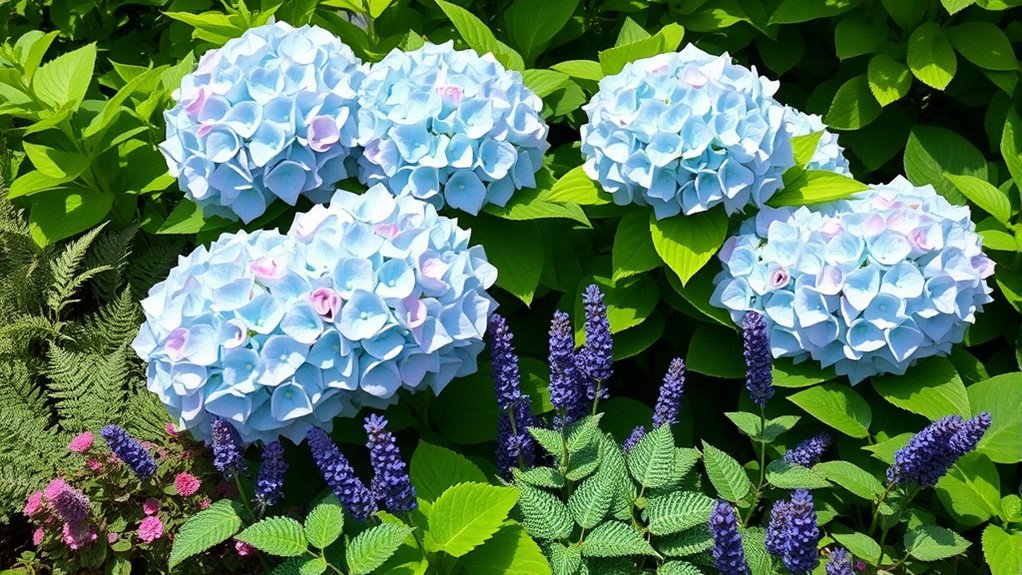
If you want your hydrangeas to shine without extra effort, pairing them with low-maintenance plants is a smart move. These easy-care options guarantee a vibrant, beautiful display with minimal fuss. Succulent companions add texture and contrast, thriving in well-drained soil and requiring little watering. Groundcover options like creeping thyme or sweet woodruff fill in gaps, reducing weeds and adding visual interest. Consider these low-maintenance partners:
Pair hydrangeas with low-maintenance plants like succulents and groundcovers for a vibrant, easy-care garden.
- Sedum varieties – drought-tolerant succulents with colorful foliage
- Creeping thyme – fragrant groundcover that blooms with small flowers
- Hosta – shade-loving, low-maintenance foliage plants
- Ajuga – groundcover with attractive leaves and purple flower spikes
These plants require little attention, making your garden both stunning and manageable.
Contrasting Forms: Structural Plants to Highlight Hydrangea’s Shape
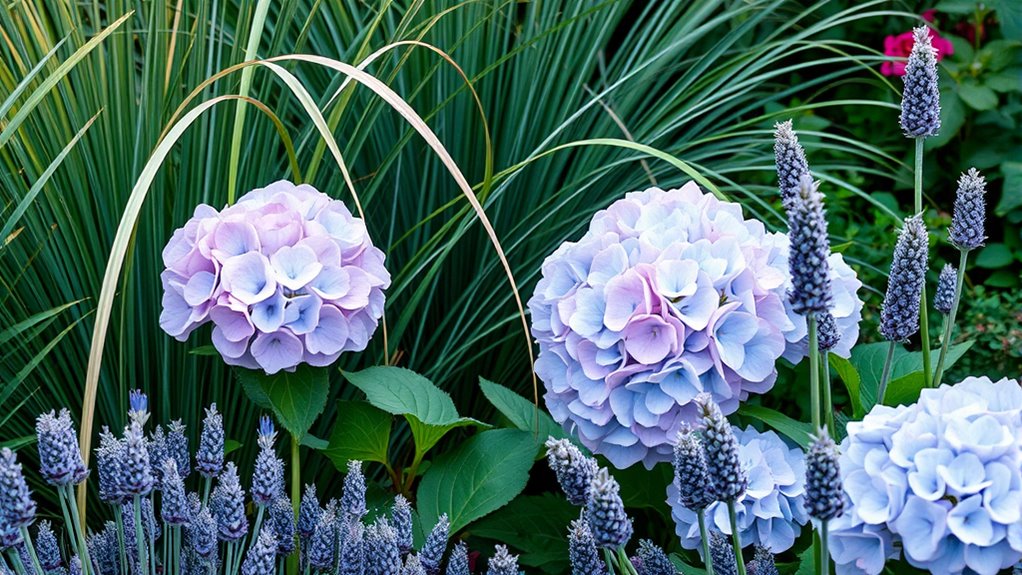
To truly showcase the elegant shape of your hydrangeas, pairing them with structural plants creates a striking contrast that draws the eye. Architectural accents like upright grasses, sculptural succulents, or bold, spiky perennials add visual interest and emphasize your hydrangea’s rounded blossoms. These contrasting forms enhance your garden’s overall structure, giving it depth and dimension. By choosing plants with strong, defined shapes, you create a visual hierarchy that highlights the hydrangea’s soft, billowy flowers. Think about incorporating plants such as Japanese forest grass, yucca, or agave, which stand tall and angular. This interplay of contrasting forms not only accentuates the hydrangea’s shape but also adds a modern, eye-catching element to your garden’s design.
Frequently Asked Questions
Which Plants Attract Pollinators to Hydrangeas?
To attract pollinators to your hydrangeas, choose plants with pollinator friendly blooms that draw bees and butterflies. Flowers like lavender, bee balm, and coneflowers are excellent for attracting bees and providing nectar. These plants not only enhance your garden’s beauty but also support pollinator health. By planting these around your hydrangeas, you create a lively, pollinator-friendly environment that boosts pollination and benefits your entire garden ecosystem.
Can Succulents Be Paired With Hydrangeas in the Garden?
You can definitely pair succulents with hydrangeas in your garden. Succulents compatibility with hydrangeas depends on choosing the right varieties and placement. Garden design tips suggest placing succulents in drier, sunnier spots where they won’t compete with hydrangeas’ moisture needs. This contrast creates visual interest and texture. Just guarantee that the succulents receive adequate sunlight and well-draining soil to thrive alongside your hydrangeas.
Are There Specific Soil Requirements for Hydrangea Companions?
Think of your garden as a recipe; the right soil sets the foundation. Hydrangeas prefer soil amendments that help maintain their pH preferences, usually slightly acidic. You’ll want to test your soil’s pH and modify accordingly—adding sulfur for acidity or lime to raise pH. When choosing companions, consider plants that thrive in similar soil conditions to ensure harmony and healthy growth.
How Do I Prevent Pests When Planting With Hydrangeas?
To prevent pests around your hydrangeas, choose pest-resistant plants that naturally deter bugs, like lavender or marigolds. You can also use natural pest deterrents such as neem oil or insecticidal soap, applying them regularly to keep pests away. Keep your garden tidy and remove debris, as it attracts pests. These strategies help protect your hydrangeas without relying on harsh chemicals, ensuring a healthy, vibrant display.
What Plants Help Deter Hydrangea Diseases Naturally?
Did you know that incorporating certain plants can naturally aid in pest control and fungal disease prevention? You can plant herbs like lavender or thyme near hydrangeas, as they repel pests and promote healthy growth. Marigolds also act as natural fungicides, reducing disease spread. These companion plants enhance your garden’s health, providing a beautiful, resilient landscape while reducing the need for chemical treatments.
Conclusion
Think of your garden as a symphony, with hydrangeas as the graceful lead. By choosing the right companions, you’ll create a masterpiece of color, texture, and harmony—like Van Gogh’s vibrant strokes on canvas. With thoughtful planting, your garden will become a timeless masterpiece, inviting admiration and wonder. So, embrace these ideas, and let your garden flourish into a living work of art that even the gods would envy.


